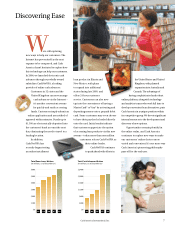Cash America 2008 Annual Report Download - page 20
Download and view the complete annual report
Please find page 20 of the 2008 Cash America annual report below. You can navigate through the pages in the report by either clicking on the pages listed below, or by using the keyword search tool below to find specific information within the annual report.
As a leader in the short-term cash advance
industry and a member of the Community Financial Services
Association of America (CFSA), Cash America acts as a
responsible lender and applies the industry’s best practices
as it serves customers. These best practices include: (1) full
disclosure of terms and conditions to each customer and
abiding by all requirements of each state, including the Federal
Truth in Lending Act; (2) compliance with all applicable laws;
(3) truthful advertising; (4) encouraging customer responsibility;
(5) limiting rollovers by the customer to four or the state limit,
whichever is less; (6) a one-day right to rescind at no cost to the
customer; (7) adherence to appropriate collection practices,
including the Fair Debt Collection Practices Act; (8) no threat of
criminal action against a customer who is delinquent on his or
her account; (9) enforcement of the industry’s self-policing best
practices and reporting violations to the proper authorities;
(10) support for responsible legislation of the industry that
incorporates these best practices; (11) offering all customers
an extended payment plan; (12) Internet lending licensed
under state law where customers reside; and (13) display of
the CFSA membership seal to alert customers of the store’s
affiliation with the CFSA and the store’s adherence to these best
practices. To review a full description of these best practices,
visit the CFSA’s Web site at www.cfsa.net.
Cash America strives to provide its customers with
borrowing options that best fit the individual customer’s needs.
In 2008, it is estimated that the cash advance industry served 19
million U.S. households and extended $42 billion of capital to
consumers.(1) Recently, several academic research papers were
published regarding the cash advance industry. The research
indicates that the cash advance option is typically the lower-
cost option for the customer, provides an important source of
much-needed capital from a licensed and regulated provider
and enhances the welfare of the community. To review some
of the more recent research papers, please refer to the Cash
America Web site at www.cashamerica.com.
(1) Stephens, Inc. March 2009 estimates.
What the scholars say about the short-term
cash advance product:
“The default policy prescription in South Africa and much of the rest
of the world (including parts of the U.S.) is to restrict access [to high-
risk, high-interest credit] based on the presumption that vulnerable
consumers overborrow in these markets. Our evidence casts doubt on
this presumption and suggests that revealed preference carries the
day: Our consumers who borrowed at 200% beneted from doing so,
at least relative to their outside options.” (1)
“Most importantly, [the study did]…not nd any evidence that the net
eects of expanded access to expensive consumer credit are negative.” (2)
“Preventing or limiting the use of payday loan services only encourages
borrowers to seek out and utilize less attractive alternatives that put the
borrower in an even weaker nancial position.” (3)
“This study nds that the industry’s proered justications for high
service fees, and by extension high APR’s, may be justied by both
high store expenses and high loan losses. In addition, this study nds
that payday lender prot margins are less than half that of their
mainstream lending counterparts.” (4)
“In order to provide a valuable service, payday lenders choose to
keep longer business hours and operate a higher density of stores
than traditional lenders such as banks. The cost of convenience is
lower protability.” (5)
(1) (2) July 2007 study, “Expanding Credit Access: Using Randomized Supply Decisions to
Estimate the Impacts,” by Dean Karlan, Yale University, and Jonathan Zinman, Dartmouth College.
(3) “Payday Lending and Public Policy: What Elected Ocials Should Know,” by Tom Lehman,
Ph.D., adjunct scholar of the Indiana Policy Review Foundation and professor of economics at
Indiana Wesleyan University, August 2006.
(4)(5) Fordham Journal of Corporate & Financial Law, published 2007.
$600
$500
$400
$300
$200
$100
$0
Comparative Data – 2008 Average Insufficient
Funds/Overdraft Protection Paid Per Banked Household
USA
$369 $542 $241
States
w/o Cash
Advance
States
with Cash
Advance
Source: Bretton Woods, Inc.; 2008 Analysis of Bank and Credit
Union NSF/ODP Programs, published January 9, 2009.
17
Acting Responsibly and Serving Customer Needs
























